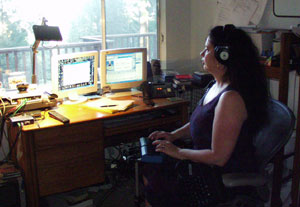Apex Captioning Company for Broadcast Captioning & Subtitling
 Apex Captioning Company provides nationwide broadcast captioning including open and closed captioning services.
Apex Captioning Company provides nationwide broadcast captioning including open and closed captioning services.
- Our captioning company also provides rolling captioning.
- We provide subtitling for TV and other programs and events including film, television and digital media.
- We provide raw footage transcripts as well as word accurate transcripts.
- We offer subtitling services in many languages including English, Spanish, Italian, French, German, Arabic, Hebrew, Japanese and other languages.
What are captions?
- Captions are words displayed on a television screen that describe the audio or sound portion of a program.
- Captions allow viewers who are deaf or hard of hearing to follow the dialogue and the action of a program simultaneously.
- Captions can also provide information about who is speaking or about sound effects that may be important to understanding a news story, a political event, or the plot of a program.
- Captions are created from the transcript of a program.
- A captioner separates the dialogue into captions and makes sure the words appear in sync with the audio they describe.
- A specially designed computer software program encodes the captioning information and combines it with the audio and video to create a new master tape or digital file of the program.
Apex Captioning Company provides open and closed captions
- Captions may be “open” or “closed.”
- To view closed captions, viewers need a set-top decoder or a television with built-in decoder circuitry.
- Open captions appear on all television sets and can be viewed without a decoder.
- In the past, some news bulletins, presidential addresses, or programming created by or for deaf and hard-of-hearing audiences were open captioned.
- With the widespread availability of closed-caption technology, open captions are rarely used.
Digital closed captioning company
Closed captioning has become available for digital television sets, such as high-definition television (HDTV) sets, manufactured after July 1, 2002. Digital captioning provides greater flexibility by enabling the viewer to control the caption display, including font style, text size and color, and background color.
1 Zenith Electronics Corporation, July 1, 2002
Real-time captioning company
 Real-time captions are created as an event takes place. A captioner (often trained as a court reporter or stenographer) uses a stenotype machine with a phonetic keyboard and special software. A computer translates the phonetic symbols into English captions almost instantaneously. The slight delay is based on the captioner’s need to hear the word and on the computer processing time. Real-time captioning can be used for programs that have no script; live events, including congressional proceedings; news programs; and nonbroadcast meetings, such as the national meetings of professional associations.
Real-time captions are created as an event takes place. A captioner (often trained as a court reporter or stenographer) uses a stenotype machine with a phonetic keyboard and special software. A computer translates the phonetic symbols into English captions almost instantaneously. The slight delay is based on the captioner’s need to hear the word and on the computer processing time. Real-time captioning can be used for programs that have no script; live events, including congressional proceedings; news programs; and nonbroadcast meetings, such as the national meetings of professional associations.
Although most real-time captioning is more than 98 percent accurate, the audience will see occasional errors. The captioner may mishear a word, hear an unfamiliar word, or have an error in the software dictionary. Often, real-time captions are produced at a different location from the programming and are transmitted by phone lines. In addition to live, real-time captioning, captions are being put on prerecorded video, rental movies on tape and DVD, and educational and training tapes using a similar process but enabling error correction.
Electronic newsroom captions
Electronic newsroom captions (ENR) are created from a news script computer or teleprompter and are commonly used for live newscasts. Only material that is scripted can be captioned using this technique. Therefore, spontaneous commentary, live field reports, breaking news, and sports and weather updates may not be captioned using ENR, and real-time captioning is needed.
Edited and verbatim captions
Captions can be produced as either edited or verbatim captions. Edited captions summarize ideas and shorten phrases. Verbatim captions include all of what is said. Although there are situations in which edited captions have been preferred for ease in reading (such as for children’s programs), most people who are deaf or hard-of-hearing prefer the full access provided by verbatim texts.
Rear window captioning company
More and more movie theaters across the country are offering this type of captioning system. An adjustable Lucite panel attaches to the viewer’s seat and reflects the captions from a light-emitting diode (LED) panel on the back of the theatre.
Current research
Researchers are studying caption features, speeds, and the effects of visual impairments on reading captions. This research will help the broadcast television industry understand which caption features should be retained and which new features should be adopted to better serve consumers. Other research is examining the potential for captions as a learning tool for acquiring English-language and reading skills. These studies are looking at how captions can reinforce vocabulary, improve literacy, and help people learn the expressions and speech patterns of spoken English.
Some information provided from National Institute of Health, National Institute of Deafness and Other Communication Disorders website.
We proudly serve our clients in the legal community who have relied on our litigation support services for reporting, videography, case management, and more.
If you are looking for a professional captioning company for live broadcasts, captioning for newscasts, captioning for stadium events or any other live or pre-recorded program, you have come to the right place.
Call Apex Captioning Company at (877)871-2654 or Contact Us for all your captioning needs or Schedule 24/7 Online.


